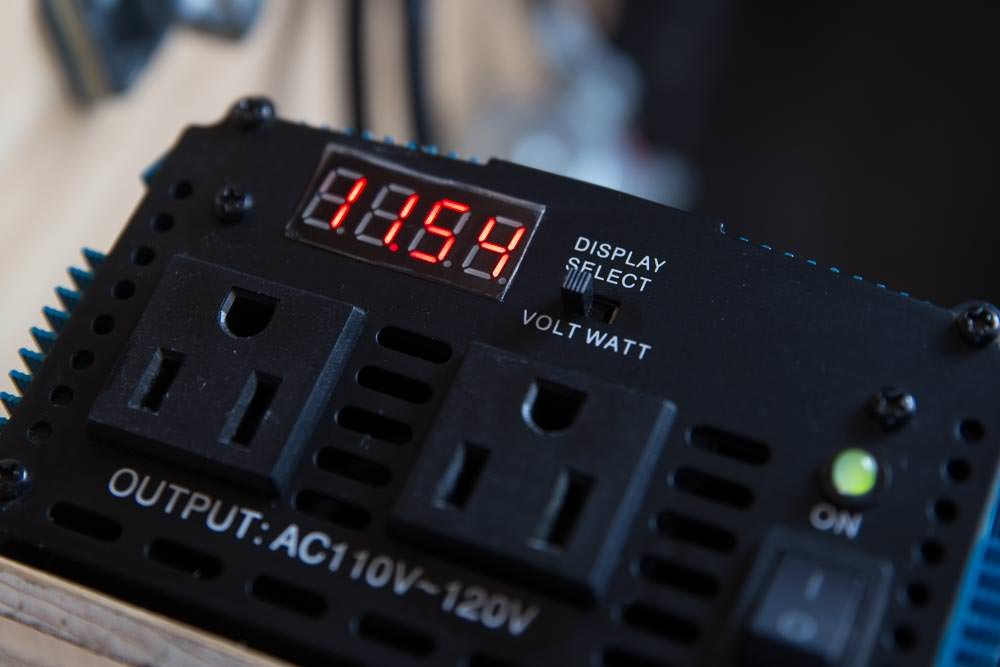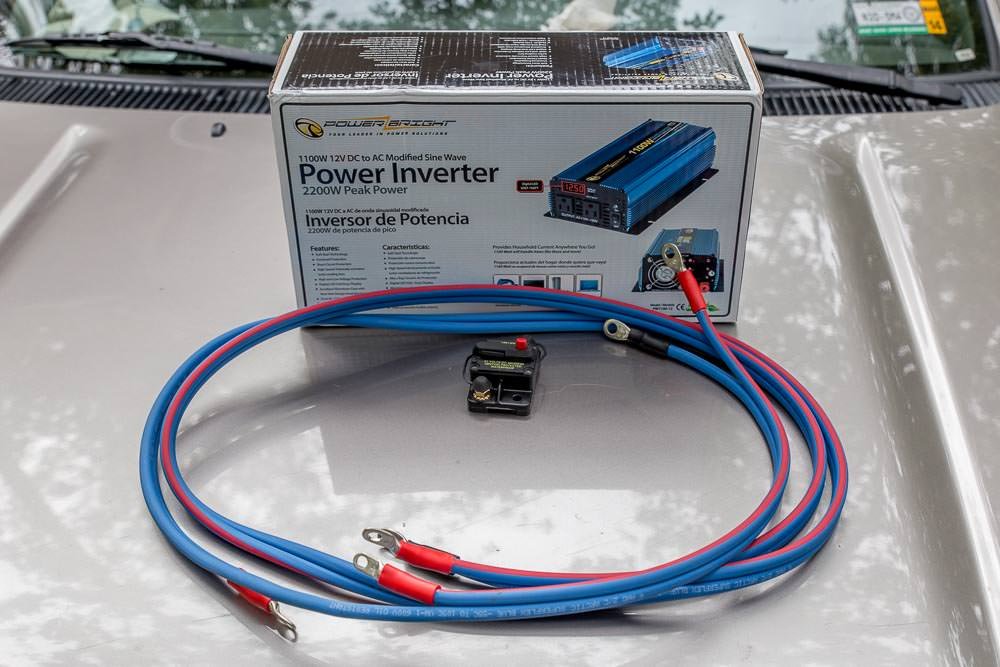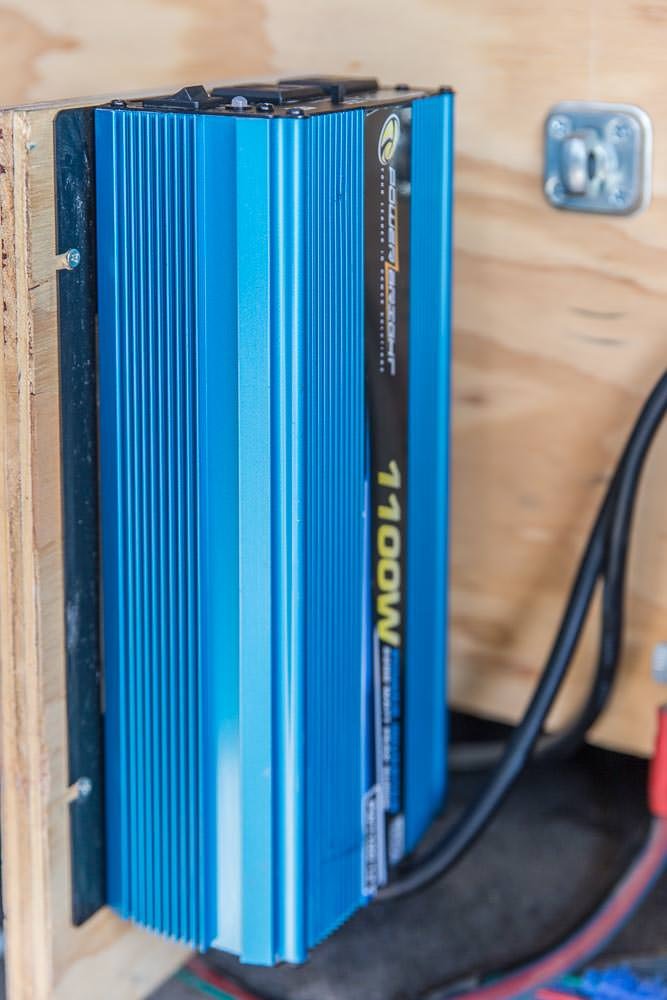Power Bright PW1100-12 Power Inverter | Gear Review

For better or worse, electronic devices play a big part in our travels. Keeping all our equipment charged and ready to go can be a nightmare.
The solution? Mains power in the truck.
It was time to go shopping for a power inverter.
The range of power inverters is overwhelming and there are a few factors you need to take into account pre-purchase. All inverters are not created equal. You could spend days reading up on what you need for a particular application based on:
- What (and how many) devices will you be running
- Where and how you will install the inverter
- How you will connect the inverter to your power source.
A lot can be said for properly researching an item before purchase—But sometimes we just like to jump in feet first. The affordability of this particular inverter, combined with the fact that neither of us wanted to do too much more reading about which kind of ‘wave’ is better (Spoiler alert: Pure sine wave is preferable to modified sine wave… ) meant we clicked ‘order’ on Amazon without all the detailed number crunching.

This is what keeps us charged, happy connected and even caffeinated (Our coffee grinder runs off mains power).
We placed our order for the Power Bright PW1100-12 Power Inverter. For our situation this particular inverter was a bit of overkill. All we needed it for was charging laptops and camera batteries, running a stick blender, powering the all important coffee grinder and occasionally allowing us to use an electric drill—not at the same time, of course. The choice of the 1000W inverter reduced the need for any number crunching—also, the price tag was irresistible.
We mounted ours to our wooden sleeping platform behind the driver’s seat . The power source is a second battery, mounted in the back (behind where the backs seats would have been). This battery is primarily used to power a ARB fridge/freezer (but not via the inverter). We did not use the included power leads since we were mounting this permanently, instead we made up the leads with appropriate terminals to the required length. The included leads also felt stiff and brittle, we would recommend replacing these regardless of how you use it.
We chose this inverter because it had more than enough watts (1100), two 3 prong outlets, it was cheap, and had acceptable reviews.
This inverter will conveniently shut itself off before it completely drains your battery. Equally conveniently it will also shut off if it becomes overloaded. The externally accessible fuses are also a plus. At this point, due to the fact that we haven’t really pushed it to its limits, these features remain relatively untested.
Manufacturer’s specifications:
- 1100 Watts continuous power
- 2200 Watts peak power
- Provides 9.2 Amps
- Anodized aluminum case for durability
- LED display—Input voltage/output wattage
- Built-in cooling fan
- External, replaceable 30 Amp spade-type fuses
- Dual 3 prong 120 volt AC outlet
- Overload indicator
- Power On/Off switch
- 3 FT battery cables included
The inverter has two 3 prong outlets which is great, but it would have been handy to have a couple of USB ports as well. To get around this we bought a short extension lead and a Phillips double adaptor with USB ports which we keep between the front seats for easy access.
Even though we flagrantly disregarded the manufacturers installation instructions. Ours is mounted vertically, in a tight enclosed space, the inverter has performed perfectly.
This is quite possibly a result of the size of the inverter vs. what we plug into it. 1100w is a lot when your mainly charging laptops, cellphones and camera batteries. The only time we have come close to overloading was using a hand drill for an extended period of time.
Pros
- Tough, anodised aluminium case
- Quiet built in cooling fan
- External, replaceable fuse
- LED display that displays voltage and output wattage
- Beeps angrily to let us know we have nearly depleted our battery
- A striking shade of blue (Emma insisted this was a pro, Ben suggested it didn’t really matter)
- Affordable unit
- Simple, easy to follow installation instructions (Which we ignored portions of).
Cons
- The included cables are poor quality
- No USB sockets
- Modified sine wave, rather than pure sine wave so may not be ideal for all devices. (Hasn’t caused us any issues as yet, although we did have a cordless drill that gave up the ghost pretty early on, this may well have been a result of buying the cheapest drill at Home Depot, rather than not supplying it the right power.)
Conclusion
The Power Bright PW1100-12 inverter is perfect for our needs. Its only tapped out the battery a couple of times and that was when we were using the drill a lot. We could have spent more time researching inverters and calculating total draw, etc. but the price and size of this particular inverter made the decision really easy. We have been using it almost daily for the past eleven months of travel and it has performed perfectly. Despite blatantly ignoring the installation instructions, we have found it to perform perfectly from the snowy nights we spent in Yellowstone National Park, to the tropical heat of Mexico’s Yucatan Peninsula.
We’ll let you know if we test the inverter’s limits in the future and decide to invest in a 50″ LCD TV for the tent or a microwave oven or anything of the sort.




